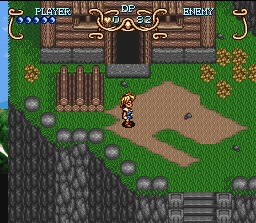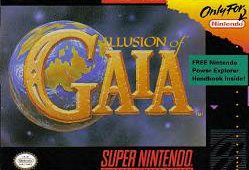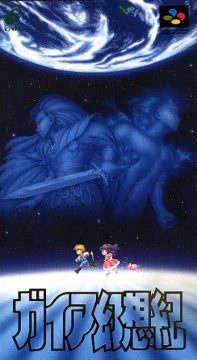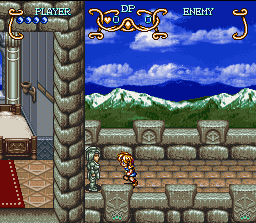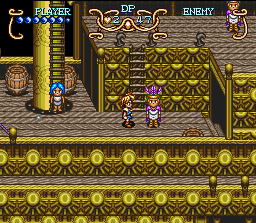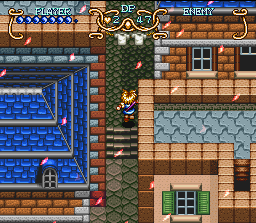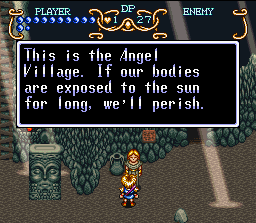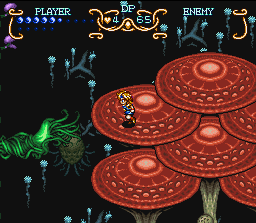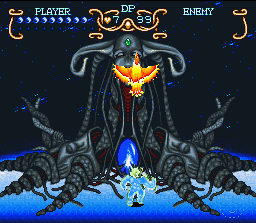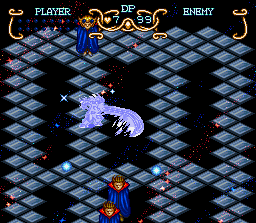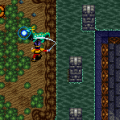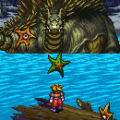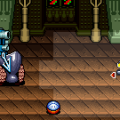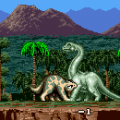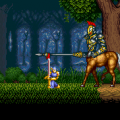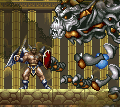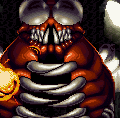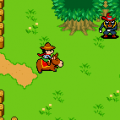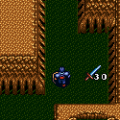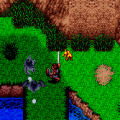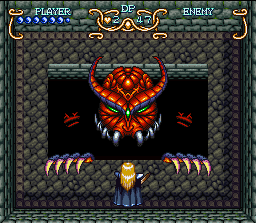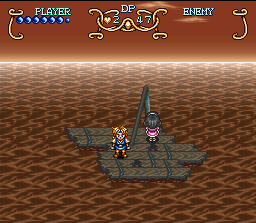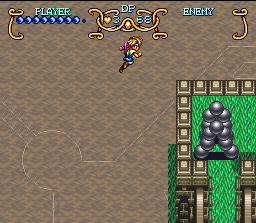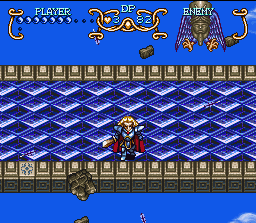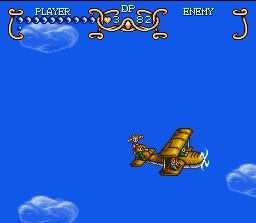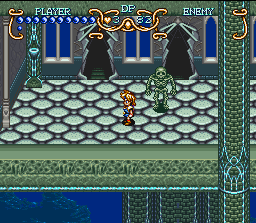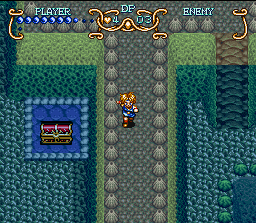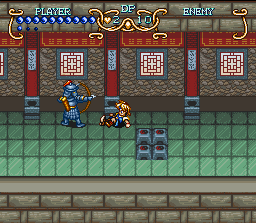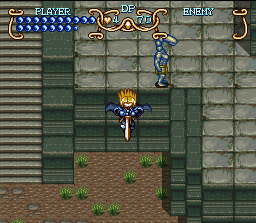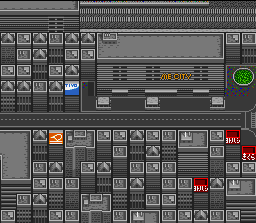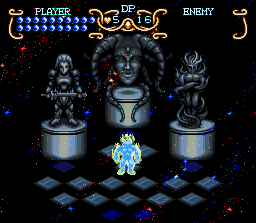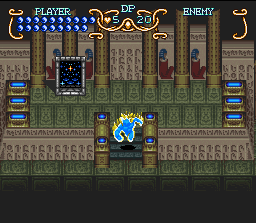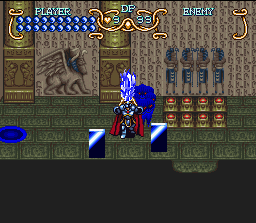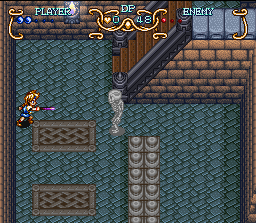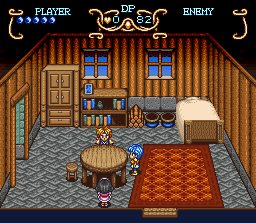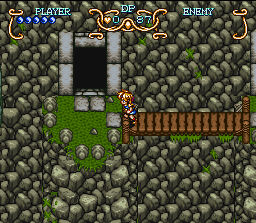Illusion of Gaia can be called the oddball of the Quintet “trilogy” of SNES action-RPGs. Where Soul Blazer, Terranigma and Granstream Saga all have fairly patterned gameplay focusing on elemental towns with several dungeons attached to them, Illusion of Gaia is an extremely linear, straightforward flowing adventure that has a defined beginning and end and no wiggling room in between. Rather than focusing on some gimmick involving resurrecting people or places, Gaia centers more on the action elements, making it far deeper, smoother, and more engaging experience than Soul Blazer.
Will is a young boy in South Cape, a small coastal city ruled over by a benevolent King. Will lives with his grandparents. His father has been missing since he went on an expedition 4 years ago. The monotony of Will’s life as a schoolboy and layabout is disturbed suddenly upon meeting a spoiled young princess named Kara, who fears that her father has changed into an increasingly violent warlord. After a short bout of imprisonment, Will and Kara are thrusted off into an adventure that’ll have them spanning the globe and learning more about the ominous future foretold by the coming of a red star that has recently appeared in the sky.
For whatever reason (most likely to build hype), veteran manga artist Moto Hagio, and also veteran novelist Mariko Ohara were hired to do the character designs and scenario writing for the game. Despite their level of professionalism, neither aspect was terribly well done, aside from the character development on Ohara’s part.
Illusion of Gaia plays out much like a Zelda game without the free-roaming aspect. The game is very linear and you’re whisked away from one place to another constantly. The major reason for this is that Illusion of Gaia tries to make its story the central element, and considering its age, it does a fairly good job at it. While essentially, none of the thematic story material is particularly original or interesting, its the approach on the characters and their growth that makes Illusion of Gaia such a fascinating tale. The story takes place over a very long period of time, and you get to see the characters grow and mature in ways that even modern RPGs seem to fail at. Illusion of Gaia is also a surprisingly dark and brooding game. It retains an almost constant atmosphere of ephemerality and death, something barely played on in Soul Blazer. Its only really story-related ties to Soul Blazer are a few minor references. There’s a dog named Turbo, and a couple denying their interest for each other by acting like they were doing something else. One of the bosses from Soul Blazer, also shows up here in a hidden fight.
Illusion of Gaia discards the seals and pretty much every other element from Soul Blazer‘s gameplay in exchange for a deeper, more satisfying gameplay engine. One of the more interesting aspects of the game is Will’s ability to utilize three very different forms.
Will
Will’s standard form is the one you’ll be using most of the time. It’s well-rounded, quick, and learns the most useful abilities. He can break walls with his dash attack, slide under narrow passages a la Mega Man in order to gain access to areas he couldn’t reach before (much like finding items in Zelda), and spin around really fast to increase his speed and clear obstacles.
Freedan
The Dark Knight Freedan is about the coolest thing you could possibly want to turn into if you were a little boy. He’s big, has a cool cape, a big sword, and is twice as strong as Will’s normal form, making him ideal for combat, especially boss fights. He also has ranged attacks that Will lacks, which are required to hit out of place switches in dungeons.
Shadow
You don’t get to use Shadow until nearly the end of the game, and while his standard attacks are stronger than Freedan’s, Freedan has special attacks that make him a much better choice than Shadow in almost every instance. Shadow fires long-range, phoenix-shaped fireballs, much like the Phoenix magic in Soul Blazer.
While the seals from Soul Blazer have been removed, the game still encourages you to kill every enemy in every area. Destroying all the enemies in a room gives you a power-up that permanently increases your HP, strength or defense. As a bonus, destroying all the enemies in a room may also unlock a path that leads to a new area of the dungeon.
Aside from the subtle growth engine, Illusion of Gaia plays out much like your average Zelda game. You traverse dungeons, encountering obstacles that can only be passed when you learn a particular skill. You’ll also need to utilize Will’s alternate forms, which can be accessed via “Dark Spaces”, which function as save points. You’ll likely have to travel back and forth between the Dark Spaces several times to switch characters in order to complete a dungeon. Because Will’s forms differ so greatly, Illusion of Gaia hardly ever gets old, because you’re always breaking up the monotony with Freedan (or once Freedan gets old, Will).
Gaia‘s graphics stand up fairly well. Will and Freedan look great and are very well-animated, but the other sprites are pretty ugly. Where the game shines is in its environments. Some of them are very impressive, with tons of detail and atmosphere. In many cases, the moody environments add a great deal of personality to the story sequences. Also helping out is a well-composed soundtrack by Yasuhiro Kawasaki. While there are one or two bland pieces, some of the music is extremely good, such as the theme of the Sky Garden and the Larai Cliff, which is one of the best layered themes on the SNES.
Many people feel that Gaia‘s less original, more linear gameplay made it a letdown, but the more in-depth gameplay engine and far less repetitive structure make it a much more solid title, and one of the best Zelda clones on SNES.
